The new year is about to start out with a bang.
For five weeks, we’ve seen Omicron double and double again. That which can’t go on forever, won’t. There aren’t many doublings left. This is it.
The CDC’s revised guidelines made it even more clear that we’re going to collectively make the right decision, let it happen, and hope for the best. It’s not like we have any choice in the matter.
A month from now, we’ll be on the way back down, and we’ll know how bad it was and what the death toll will end up looking like.
Two or three months from now, if all goes well, The After Times can begin in earnest after all the previous false starts.
Executive Summary
- Cases way up despite holiday, and will keep going up.
- Testing is increasingly difficult to get.
- Too early to know if hospitals will be able to handle it.
- See Omicron Posts (#10 from Tuesday) for further details.
Let’s run the numbers.
The Numbers
Predictions
Prediction from last week: 1.85mm cases (+80%) and 10,200 deaths (+10%).
Results: 1.81mm cases (+77%) and 8,599 deaths (-6%).
Prediction for next week: 3.5mm cases (+94%) and 10,800 deaths (+25%).
Note that some other sources have more cases than Wikipedia for the past week (e.g. BNO reports the total case count as closer to 2.1mm).
With how much things are changing each day and how many confounders there are, getting the case count that close was largely luck.
What will happen this coming week?
Uncertainty is through the roof on that, except that it will be a lot higher as we enter fog of war. Testing capacity will be exhausted and thresholds to get tested will rise in some places while desperation to get tested pre-emptively rises in others. It’s possible a few places like NYC will peak, while others haven’t fully taken off yet. On top of it all, we don’t know how much the holiday ended up slowing things down, and how much of what’s happening the past few days is filling in a backlog, so we don’t know what the right baseline is.
I’m going to go with an average of 500k cases per day, for 3.5mm total. I wouldn’t be that surprised to miss high by up to a third, or miss low by quite a bit if things are still doubling every few days and we manage to identify enough of those cases.
This is it.
On deaths, it looks like the West and Midwest are still on vacation in terms of reporting deaths, and it’s not obvious they’re going to fix this by next week. Which means they might backfill those deaths (which would count and not be corrected) or they might continue not to report. This assumes they’ll probably at least report the correct share, but it’s hard to tell.
Deaths
Tennessee had a giant backlog dump, of which I’ve substracted 1,800. We don’t get to add in all the obviously missed deaths in the West and Midwest, so I missed high here.


What we’re seeing here is still Delta combined with holiday reporting. It will take another two weeks before we have much color on the real death rate going forward. Three weeks to be sure.
Cases

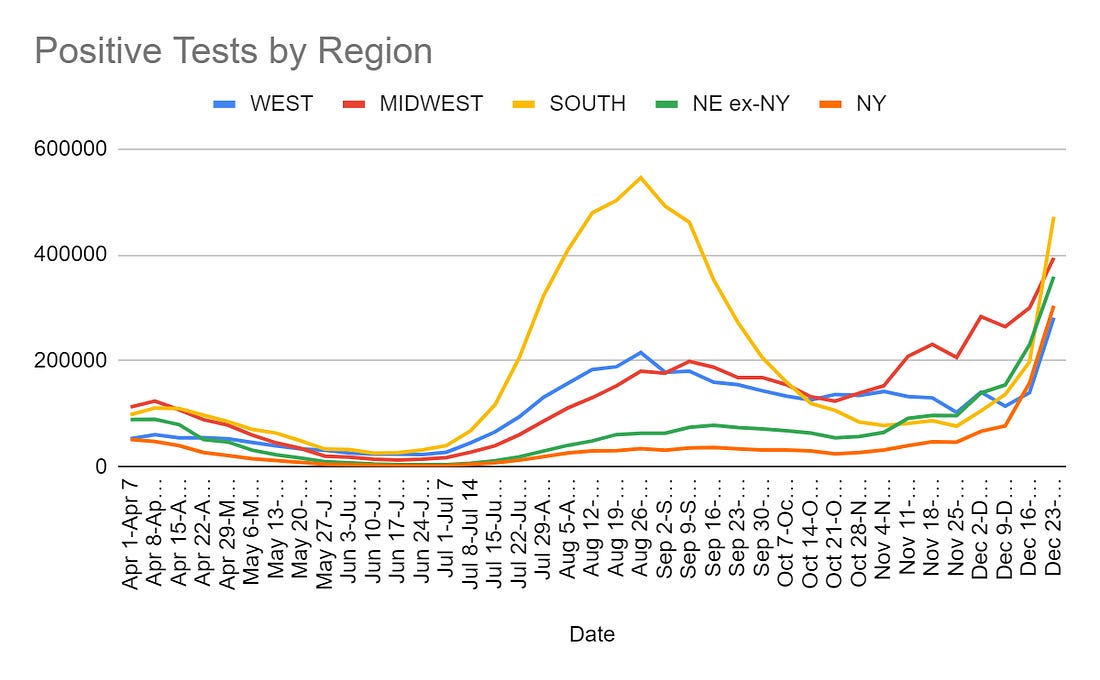
Also this handy map that updates in real time.

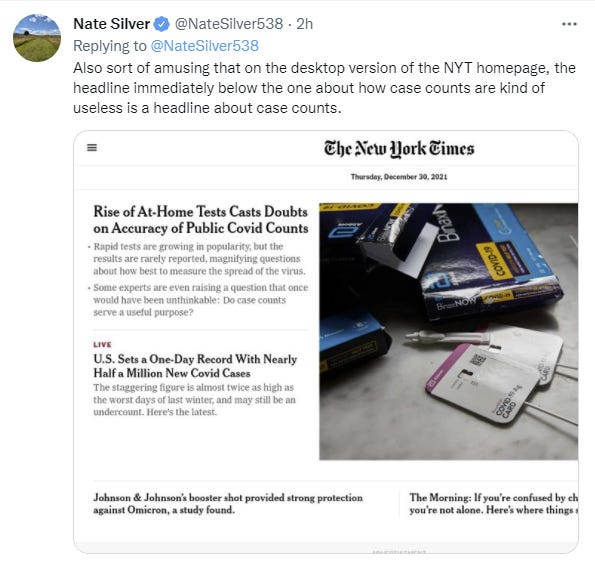
One way to estimate the true rate of cases is to look at the rate of incidental Covid-19, which is the positive test rate of a random sample. People who land in the hospital for non-Covid reasons aren’t the most random of samples, but they’re also not the least random either? Plus, if you have a baseline, you can control for the bias in the sample (in both directions) by comparing similar populations.
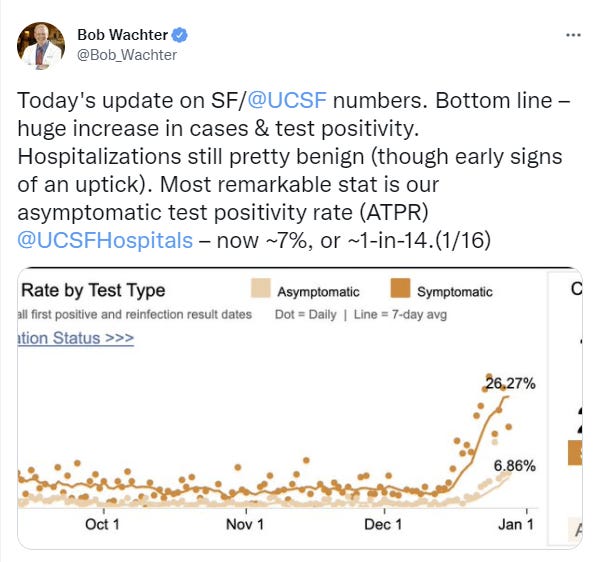
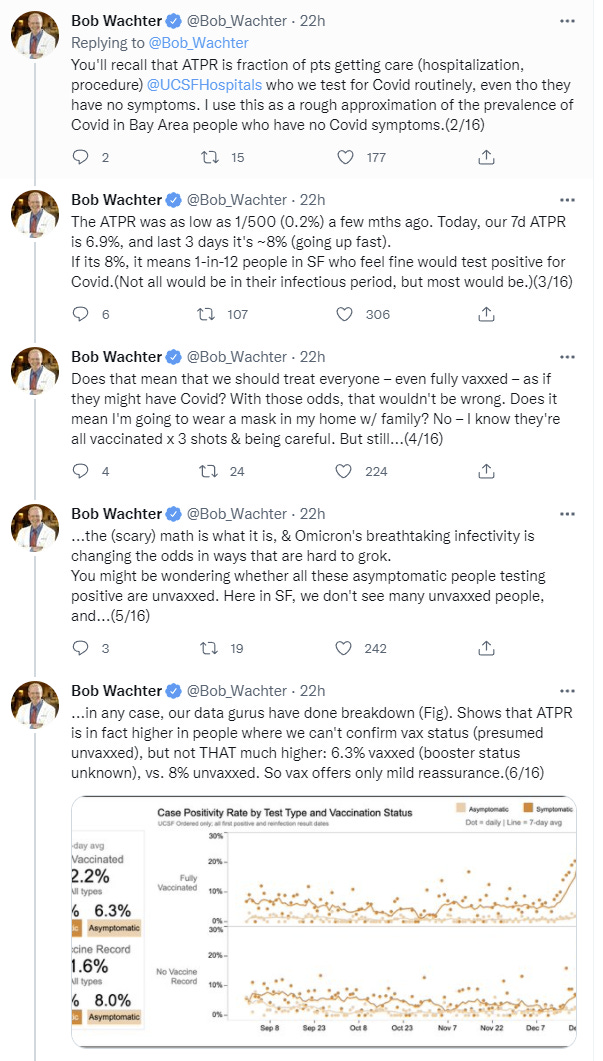


I was about to kick myself for not getting onto this method of analysis earlier, except that it’s not available anywhere else?

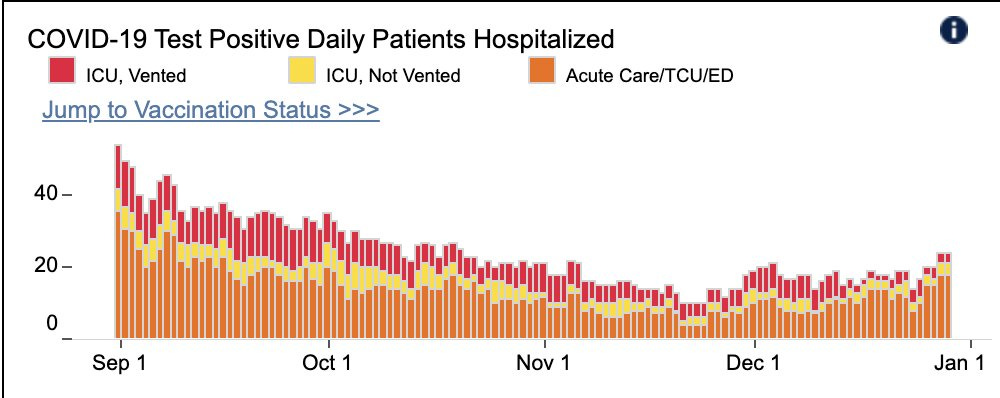
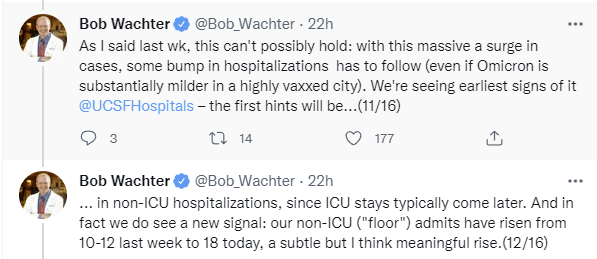


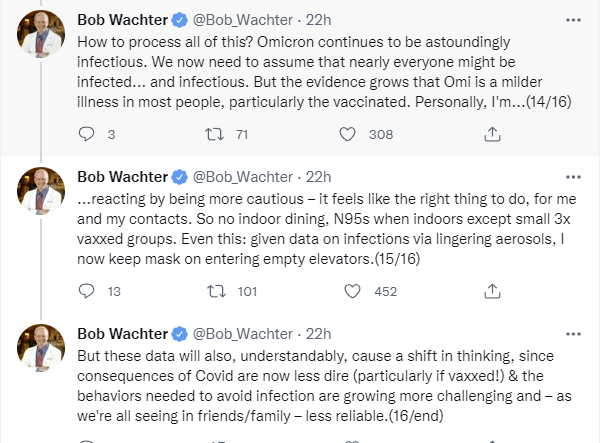
Vaccine Effectiveness
Canadian data shows vaccines have been super effective, a 20x reduction in deaths, but that was prior to Omicron.
Israeli study finds booster is 90% additionally effective on top of previous two shots, in terms of preventing deaths, also prior to Omicron.
You know what we still never got anywhere on settling, and which is super relevant right about now? The extent to which vaccines make some people immune to infection while others largely aren’t, versus the extent to which they make most people less vulnerable to infection in each encounter but not fully immune.
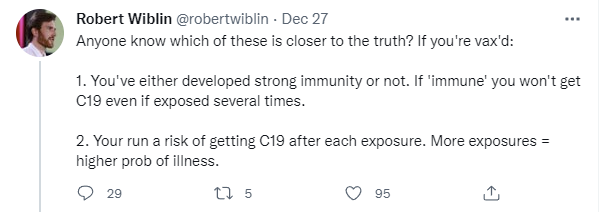
This has always been important, but Omicron makes it even more central. If it’s fully option one, then it makes sense at this point to be essentially fully all-or-nothing (or a-lot-or-not-much, at least) on risks once you’re boosted. Either you’re immune and you’ll be fine, or you’re not immune and you were never avoiding Omicron anyway, it wasn’t worth it. If it’s fully option two, paying more attention to marginal risks is justified.
My model now says it’s a hybrid. People have different levels of antibody and other responses to the vaccines, which means some people are effectively fully immune (at least for a while), others get more limited protections, and you get some Bayesian evidence over time for where you stand based on how much risk you take and whether you get infected.
Vaccination and Vaccine Mandates
If you’ve declined to be vaccinated, you’re also likely going to decline to take Paxlovid.
Of those who were familiar with the Pfizer pill, the poll found 84% are likely to take it if they test positive for the coronavirus, with no large differences between generations, racial groups, or political affiliations.
But there was one key difference: 91% of vaccinated people would take the pill, but only 52% of all unvaccinated Americans said they are very or somewhat likely to do do so. The likelihood an unvaccinated person would take the pill dropped even further — to 35% — among those who said they would never get vaccinated, compared to unvaccinated people who said they will “wait and see.”
That’s a huge correlation. I’ve seen some grasping at straws that Paxlovid might somehow be dangerous, but mostly everyone agrees it’s great and it’s not at all a political issue. So this suggests the vaccine hesitancy largely isn’t about politics or any concrete concerns either. Half the people who aren’t vaccinated have sufficiently strong priors against doing anything new that they’re having none of it, it all sounds super suspicious to them, and you’re not going to tell them different. The alternative hypothesis, which I find less plausible, is that the political divide carries over to everything else automatically at this point, which is functionally the same but has some different implications.
I notice I’m not sad about it. It’s a scarce treatment, so if some people don’t want it, there are plenty of others that do.
Justin Trudeau’s attitude here seems like exactly what one would want, politely asking citizens to do the thing he believes is best. So, a proportionate response would be… give me liberty, or give me death?

That doesn’t mean that the mandates we have are wise or reasonable or make any sense as prevention as opposed to punishment. If your mandates don’t start going into effect until January 15, and they ramp up in March, what’s the point? I don’t expect it to be ‘over’ by then but the peak would have already at least be close.

(Editorial link, it’s standard stuff.)


I do think that the similar original NYC mandates were (at least in part) object-level attempts to accomplish something. I don’t think anything imposed going forward can make that claim.
Also, sometimes you don’t have enough workers so you don’t enforce your vaccine mandate to avoid shutting down services, you can just say that, except no, you can’t say that, so you pretend bus drivers are isolated from the public.
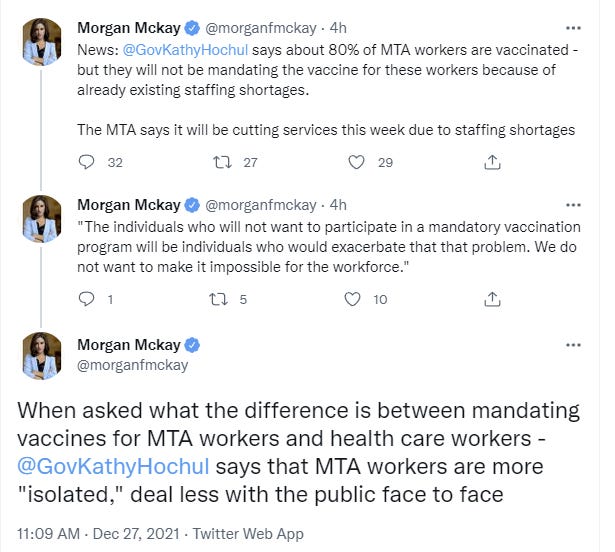
CDC Revised Guidelines Continued
I wrote a post yesterday about the CDC’s revised guidelines on how long to isolate if you test positive for Covid-19. The story very much continues, so consider this a Part 2.
First off, there’s no longer any ambiguity about what happened here, I mean, ‘cmon.

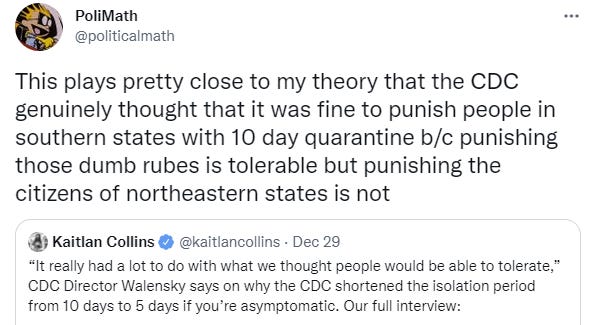
While his hypothesis cannot be confidently dismissed, I am not as cynical in that particular way. I think the CDC simply does not care about your life and how much they mess it up, they care about ‘public health’ as a sacred value. Except they do care if the metaphorical and also literal trains stop running, or what guidelines people would simply ignore, in which case compromises get made. They care, as Walensky admits, about what people ‘will tolerate’ so the whole game doesn’t fall apart.
I believe Fauci here, sometimes authorities do tell the truth, it’s how they keep us on our toes.

And again, that is exactly what we should do. If society wouldn’t run under your rule, you need a new rule. The rules are made for man, not man for the rules. That shouldn’t require the threat of full breakdown of basic functions of society, but that’s better than actually letting basic functions break down.
And when that happens, you should say that this is what happened, explicitly, exactly like this.
Here’s the top reply.

Actual answers, in order of importance, not kidding, here are the Five Good Reasons:
- Either double it, or cut it in half.
- The Law of Fives.
- KISS principle: Keep it simple, stupid.
- Generation time is down.
- Five days is still most of the infectiousness.
The chorus of ‘we must stop this or at least slow it down’ will always give the same answer, so their statements mostly aren’t useful evidence.
Is five days a reasonable rule? How well does it work? Does the math make sense?
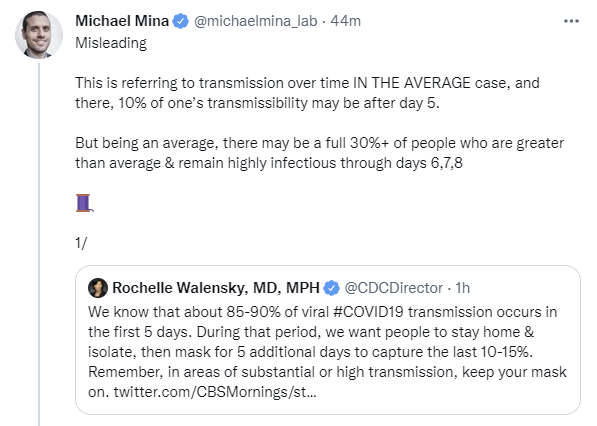

I totally agree with Mina that a standard that includes testing would be better, but I don’t see this as a strong response to Walensky here. About 30% of people being infectious on days 6-8 is fully compatible with 85%-90% of transmission happening in the first five days. If we do a quick very wrong approximate calculation and assume everyone is infectious days 2-5, then 30% also infectious on days 6-8, then that’s about 82% of infectiousness in the first five days, so it wouldn’t take much gradual additional decline to get to 85% or even 90%, and we can use whether you’re symptomatic as an additional filter on top of that.
This is the traditional argument between ‘X is true on average’ and ‘X is sometimes false in a particular case’ over which one matters in a given situation.
If we didn’t have rapid tests and could only do PCRs that come back positive for way too long and thus aren’t useful here, would five days look reasonable? Under current circumstances, absolutely, yes. If 10% of London or New York is infected at once and you’ve waited long enough to deal with 90% of your infectiousness already, how much riskier than average are you at that point? Are you making things meaningfully worse by not isolating?
Once you have the option of a rapid test, there’s the chance it might come back positive, so that makes such actions more blameworthy, but it doesn’t make the average outcome worse when you have the opportunity to do better. So yes, we should do better if we can.
The bottom line issue is that it is now an online meme joke that the CDC has no credibility (and before taking this seriously again, here are my favorites from the last day or so, apologies in advance).








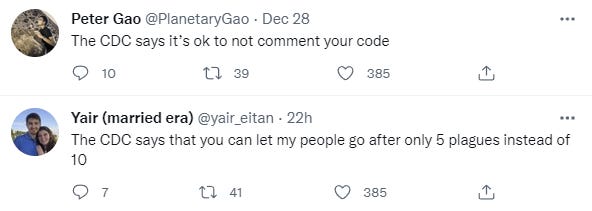
And we’re back.

As usual, it’s worth noting that the CDC nuking its credibility is bad to the extent that the CDC is credible, but is good to the extent the CDC is not credible. Better that more people have an accurate view.


When people say things like ‘I can imagine a read not wholly centered on corporate profits’ even in a thread where every time they look at a particular decision they see good reasons it was made, that does seem like the loss of credibility has perhaps gone too far, CDC Delenda Est notwithstanding.
Also, if people are going to react like this every time you change your guidance to be more lenient (and oh my is it a clear pattern) than the incentives are clear.
Help me debug this, I trained my machine learning system by punishing it every time it admitted its estimates were too high and after the first few revisions it now never lowers its estimates, I have no idea what is wrong and my family is dying.
I continue to be less sympathetic to the stealth edits that have major practical impacts, and a continued refusal (as far as I can see) to explain clearly what’s going on with the whole ‘symptoms are resolving’ clause. If the rule is ‘no fever’ then that’s a clear rule, why not say that?




Are people following the various guidelines? Do they make sense? You tell me.

Testing, Testing, Hopefully
I wrote an entire post last week about the testing situation and how much it was botched. Vanity Fair notices the hole goes even deeper. The medical establishment’s war on testing is ancient, for testing threatens their turf. By which I mean, it wouldn’t be safe, of course. People might act in response to information without proper medical advice. Perish the thought. Can’t be too careful.
So, we ban, then act confused when there’s a shortage.
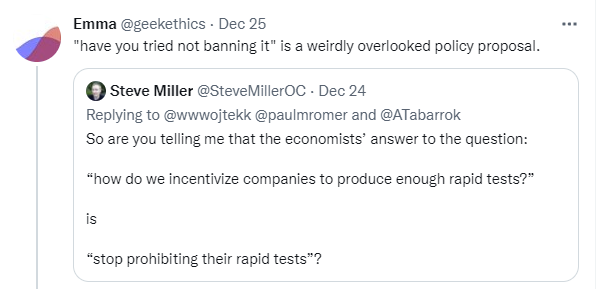
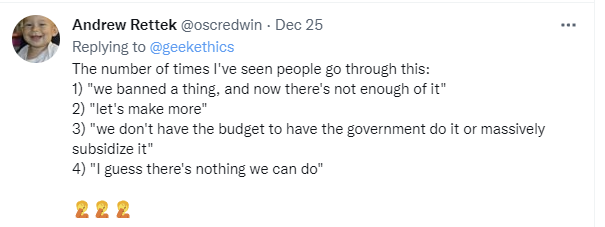
Remember the thing Biden ‘wished he’d been thinking about back in October?’ Turns out exactly that plan was explicitly proposed.
The plan, in effect, was a blueprint for how to avoid what is happening at this very moment—endless lines of desperate Americans clamoring for tests in order to safeguard holiday gatherings, just as COVID-19 is exploding again. Yesterday, President Biden told David Muir of ABC News, “I wish I had thought about ordering” 500 million at-home tests “two months ago.” But the proposal shared at the meeting in October, disclosed here for the first time, included a “Bold Plan for Impact” and a provision for “Every American Household to Receive Free Rapid Tests for the Holidays/New Year.”
I don’t think Biden is lying here. He does wish he considered it, which means he didn’t consider it, which means that he isn’t thinking about concrete policy proposals. He is not running the show or even thinking about how the show might be run. Staff is in charge.
The administration instead, as we all know, chose to mock the very idea.
On December 2, with omicron threatening an imminent wave of new infections, Biden announced a smattering of smaller-scale plans that included requiring insurance companies to reimburse privately insured patients who buy at-home rapid tests, which sell for as much as $35 for a box of two tests—if you can find them amid widespread shortages. Four days after that, White House press secretary Jen Psaki seemed to deride the very idea of free nationwide home tests. “Should we just send one to every American?” she mused sarcastically from the briefing room podium. “Then what happens if you—if every American has one test? How much does that cost, and then what happens after that?”
Did that many doctors didn’t merely oppose at-home HIV tests on the pretext of patients potentially doing something after learning important life information, they also opposed at-home pregnancy tests for the same reason?
Once Mina began to advocate for rapid home tests, he encountered the same mindset: doctors “trying to guard their domain.” Some doctors had long opposed home testing, even for pregnancy and HIV, arguing that patients who learned on their own about a given condition would not be able to act on the information effectively. Testing, in this view, should be used only by doctors as a diagnostic instrument, not by individuals as a public-health tool for influencing decisions.
A similar view prevailed within the FDA.
Most of you already know this, but it’s worth hammering home how different the testing situation is in Europe than in America:
With roughly 200 different home tests approved in Europe, the price is as low as $1.50 a test, said Schatz. “You go to offices and meetings, you see these tests lying around. It’s a free giveaway, like masks.” Schatz says the prevalence of home tests reflects a different mindset: “I really like the aggressive use of testing and the acceptance of this being a key pandemic tool and embracing the value of information, which tests provide, and accepting some of the weakness.” By contrast, some of the biggest testing companies, from Siemens to Roche, have not had rapid tests authorized by the FDA yet.
Yet even with that level of dedication to supply, Omicron has already overwhelmed demand, presumably because behaviors under virtually-free testing burn through tests at an astonishing rate, because why wouldn’t you do that?
The U.S. is not the only country facing a shortage of rapid tests, as omicron sweeps the globe. This month, the British government ran out of rapid tests that it distributed through an official website. In Spain, pharmacy shelves were empty of rapid tests, after demand rose 500 percent in November. In Canada, after provincial governments vowed to distribute millions of rapid tests at pop-up sites, many citizens seeking them went away empty-handed.
What tests we do get are then going largely to schoolchildren so we can feel better about sending them to school, rather than reserving them to do anything useful. Symbolic use over actual use.
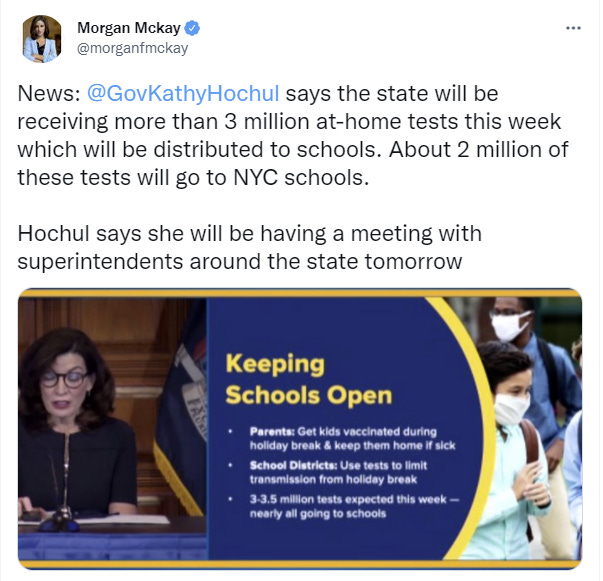
Good news is that we’re now producing tests ‘as fast as we can’ given the restrictions imposed, and the fact that it’s too late to do most of the things that would expand production.
Even better news is that it seems we have approved an additional rapid test from Roche. And then another, from Siemens. Every little bit helps, even when it’s both too little and too late. Go ahead, take your victory lap, I’ll take what I can get.

Testing lines were super long before the holidays, but that could have a lot to do with paranoid relatives demanding extra tests. Whereas this week the kids are off school and don’t require tests, and the gatherings are over, which may explain why I saw one test tent on Sunday night with no waiting line.
Others are paying $300 per test, and also suggesting the correct market solution. More thinking like this, please.


Testing situation is quite bad in the UK (source).
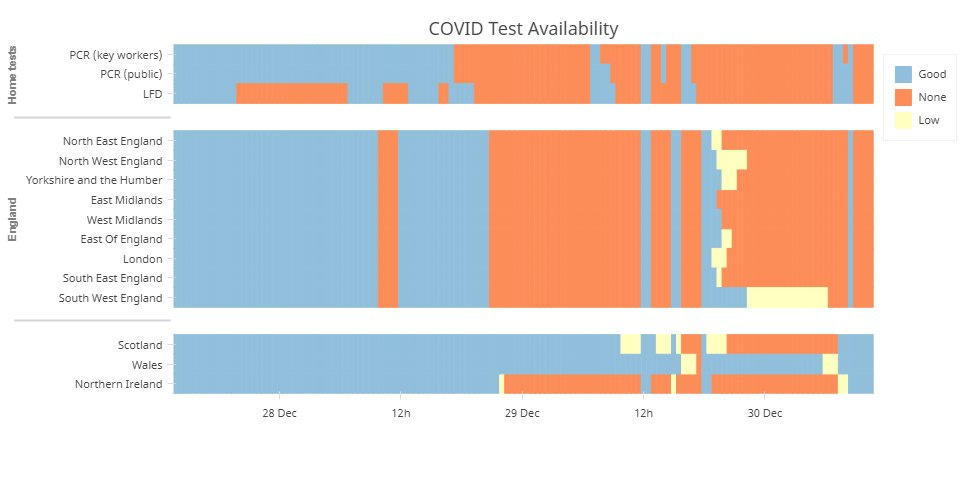
Testing in some places was outright impossible even when urgently needed. While we’re allocating tons of tests to schoolchildren, the hospitals don’t have enough?


Also worth noting that rapid tests do have false negatives especially as used in practice rather than in theory, on top of the thing where they’re testing infectiousness rather than whether you have Covid.
Meanwhile, you heard it here first, the origins of the next supervillain.
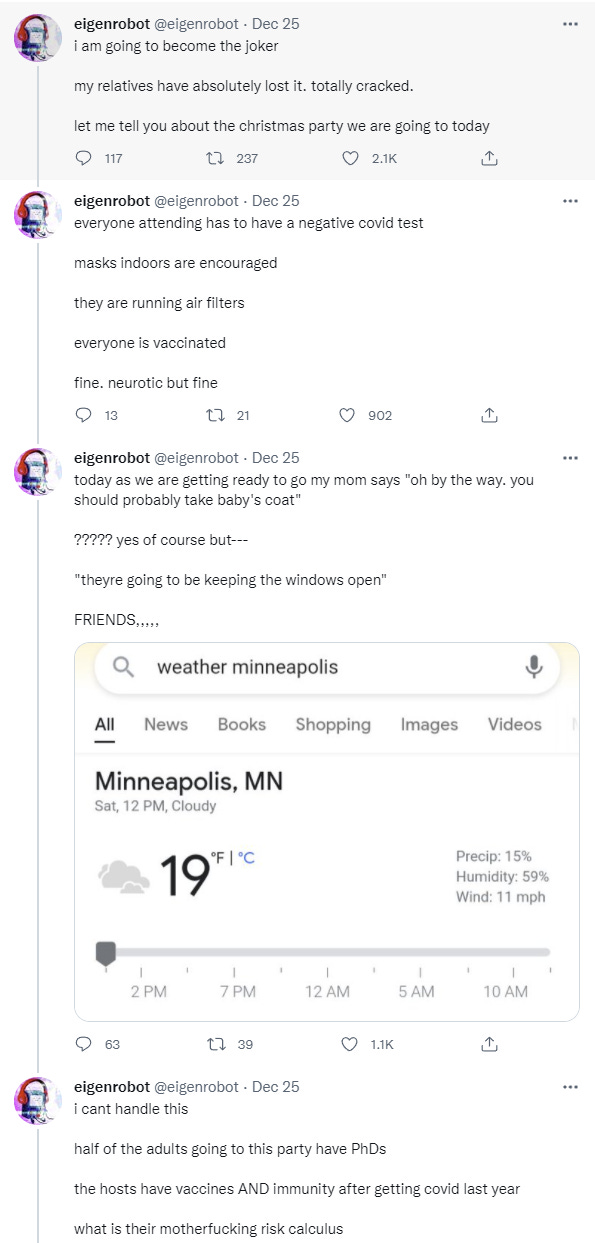
Another interesting Christmas anecdote, from the comment section:
Anecdote from the holidays about the difficulty of deciding how to use testing:
Big, difficult-to-arrange extended family gathering (~20 adults) with agreement that everyone would rapid test on the day of. Christmas morning rolls around and a crucial participant tests positive. We give her another rapid test from a different brand. Negative. A third rapid test from the same box as the first. Positive. We scramble and fortunately find a PCR site that can get us same-day service. Negative. Apparently the original box was one of the ~1% of lots that produces a false positive. But we burned through most of our spare rapid tests and most of Christmas Day figuring that out.
Arguably we got unusually unlucky with the false positive, but in the aggregate something like this was pretty likely to happen and it’s difficult to know how to follow up on a positive rapid test.
If someone at our gathering had a positive test, we would have cancelled for sure. This seems like going above and beyond, the person must have been very crucial. I do suppose multiple negative tests from multiple other sources can point towards ‘this box is faulty’ but it seems tough to be confident about that. What I probably would have done is give someone else who tested negative a test from that same box you are worried about?
Long Covid
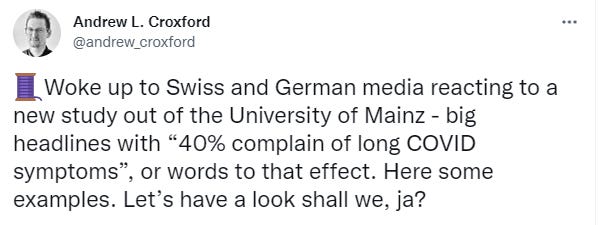
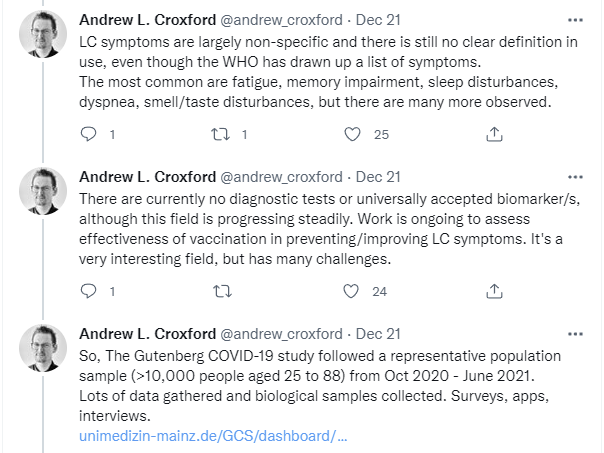

I’m surprised that 61.9% of positives had already been caught by PCR.
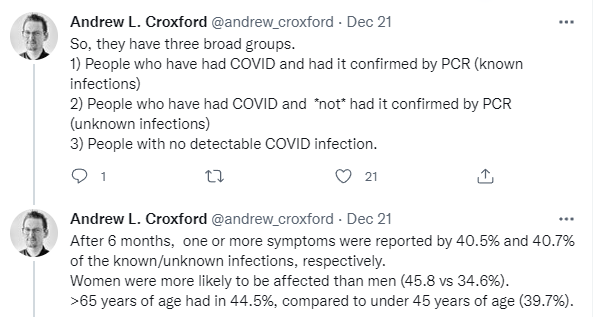





Finally, a control group, and it looks like it controlled for quite a bit.
Assuming this is being reported correctly, it’s saying that if you have an unknown infection, you don’t get meaningful Long Covid.
This at least rules out the hypothesis that Long Covid is a threat in asymptomatic cases. If you don’t realize you had Covid, your rate of reporting symptoms doesn’t rise, at least not a substantial amount.
We could in theory give the benefit of the doubt that everyone with symptoms got a PCR test, but I’m still awfully suspicious of zero effect, especially when other claims sometimes involved not differentiating much based on severity of the infection.
To the extent that Long Covid is a non-placebo Actual Thing, this seems to strongly suggest that it will indeed scale with the severity of infection, so vaccinations and booster shots will help a lot, and if you’re at low risk for Short Covid (as it were), you’re also therefore not at such high risk for Long Covid either. The idea that children were getting permanently crippled by otherwise harmless infections all over the place doesn’t match this data at all. Long Covid, and the rise in morbidity in the year after Covid infection, are likely the result of Covid infections that get bad and do a bunch of damage.
That also implies that Paxlovid and other early treatments will improve Long Covid outlooks.
Think of the Children
If you play to win The Game, and for one shining moment you do, then your students are going to get excited, and proper pandemic strategy is going to get weird.


This for once is not me making fun of Michigan University and its football program. Not only did they beat the dastardly Ohio State and make the playoffs, of course they’re underdogs who might be overmatched but I still think that over all possible worlds +7.5 against Georgia is good value, and they’re asking the right questions. So this, but unironically.


No, really, this is exactly how epidemiology works. You’d prefer people not congregate in one place and throw parties together. If they’re going to do that regardless, it’s no longer a consideration in deciding whether to do something that would cause that, like bringing students back to campus, or even scheduling classes. It’s about physical actions that cause physical risks, and doing the math.
And of course, no such situation would be complete without blaming the CDC for the one time it tried to be compatible with life.
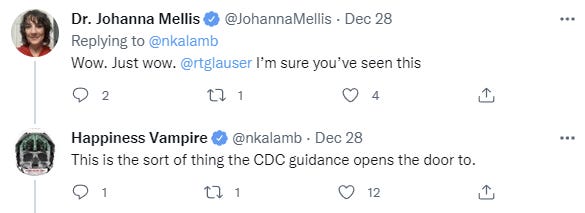
Again, that is exactly right. The CDC guidance would otherwise make the living of life impossible. By making it possible, they opened the door to life being lived. Oh no.
They are also mandating booster shots be completed by February 4, at which point the booster won’t accomplish much, but mostly that’s a shrug.
A Note on “Remote Learning”
Marginal Revolution linked back to this 2012 post on Why Online Education Works. It is an excellent post, treating online education (as opposed to online school) as an opportunity to improve rather than a burden of mimicry.
I see three principle advantages to online education, 1) leverage, especially of the best teachers; 2) time savings; 3) individualized teaching and new technologies.
That seems exactly right. When you are doing online education you get many huge benefits. Everyone can:
- Get the best teachers.
- Take the best classes.
- Get the best version, with extra preparation time, designed for remote learning.
- Take the classes they care about.
- Take classes on the schedule that works for them.
- Go at their own pace, pause, watch again, review.
- Use the internet and other new technologies as resources.
- Have zero marginal cost.
- Ask questions and get answers.
- Put the focus on learning rather than time spent or credentialism.
Now look at what we did over the pandemic with ‘remote learning’ and notice we got at most two and arguably none of these ten advantages.
Some implementations gave students (9) the ability to ask and answer questions, or to some extent (7) use the internet, but that’s about it, and not consistently or at full power.
They definitely didn’t get any of the (1) best teachers, (2) best classes, (3) best or properly customized version, (4) that they care about (5) on a schedule that worked for them (6) at their own pace (8) at zero marginal cost (10) with a focus on learning rather than time spent or credentialism.
Instead, we did our best to duplicate the physical classroom with all its problems not only intact but amplified by having to implement them via screens.
Students got their old teachers, who had signed up for a very different experience and many of whom (very understandably) hated their new jobs, teaching the same classes they always had, with little time to prepare for this entirely different world. Laser focus was often on whether a student was physically at a keyboard, or even looking directly into a camera, because otherwise they wouldn’t get credit for time served. That meant periodic checks to see who was ‘present’ and ‘paying attention’ which rules out any attempt to actually learn via going faster or slower, or focusing where one is confused or curious. All the innovations we’ve had over decades in online learning were ignored in favor of a zoom call, and all in the service of not ‘missing school.’
Is it any wonder kids hated it, didn’t learn and became depressed?
We have tons of great educational tools to teach kids things on tablets and computers, including educational games and Khan Academy and lots of other things designed for the medium, or by reading books (yes, books still exist) or playing with physical objects, or listening to the radio or audio books.
In Other News
Gain of function research finally has someone willing to stand up and defend it.

Exactly right. At best, this piece what we like to call ‘complete and utter bullshit.’ The argument is that technically ‘gain-of-function’ includes any attempt to do almost anything, so of course ‘gain-of-function’ as in ‘let’s make this virus more dangerous to see what would happen, no it won’t leak what are you talking about that definitely never happens, things don’t escape from labs’ must be fine.
No, seriously, this the line chosen here (and this is Stat News, which is normally excellent, so I can’ consider this a strawman):
Johnson & Johnson’s Covid-19 vaccine is a gain-of-function approach. It uses a type of virus called an adenovirus to deliver a portion of the SARS-CoV-2 genetic material to the body’s cells, where it stimulates an immune response that protects people when they become infected by SARS-CoV-2. Adenovirus does not naturally produce this genetic material: It was engineered to do so through gain-of-function research. This general approach is not unique to the SARS-CoV-2 vaccine; vaccine production has long been supported by similar gain-of-function approaches.
I’ve got a suggestion. We get together and work out a definition that allows ‘gain-of-function’ when the function is engineered to be part of a treatment or delivery system meant to be put into humans we’re looking to help, and differentiate it from ‘gain-of-function’ when it involves the virus gaining functionality in terms of its ability to infect, sicken and kill us, no matter how many times you say it would help you ‘see what happens.’ Or alternatively, you notice the definition in the existing bill proposed already does that. Capiche?
If this is what a defense looks like, there is no defense.
Some have even called for an end to gain-of-function studies altogether without recognition that it is a widely accepted research technique employed by scientists around the globe.
Doing that would be short-sighted.
With the push to negotiate and pass the U.S. Innovation and Competition Act, which includes language that would have harmful ramifications on viral gain-of-function research, it is imperative that Congress modifies the act before the landscape of research is altered for decades to come.
Oh, we’re fully aware. We recognize. If it wasn’t a research technique scientists were employing, we wouldn’t need to ban it. That’s exactly the problem.
So this is excellent news, that there is indeed an attempt to do at least something about Gain of Function research. I’d love to be at ‘and then they fight you’ on this one.
New York City cuts quarantine period to five days for ‘essential workers’ including not only health care workers, but grocery store workers, teachers and nursing home workers.
“Phew, so if you work in one of those Targets that has a frozen food and granola bar section – 5 days,” New York City Councilman Joe Borelli wrote on Twitter. “Work at the other ones – 10 days, it’s just not safe. Together we can stop the spread. #science”
…
“We need you again, we need you to be able to go to work,” Governor Hochul said.
Full official guidance here. As the opposition points out, five days either is safe or isn’t, and nursing home workers are the worst possible place to bring people back early, for obvious reasons. The ‘official’ positive rate is 0.3% of the population per day in NYC, and the actual rate much higher. It would be more dangerous to have health care workers wait ten days than to wait five days. Do we draw the same line at grocery stores, or accept longer lines at grocery stores?
WHO Delenda Est, they really are doing their best to kill you. If it was intentional, how would they act differently?

More of the same WHO talk later on.
Note that a booster is actually more efficient at protecting against Omicron than the first two vaccine shots, so this is malicious on even more levels than it was before.
Finally, if it’s this easy and all he really wants is a little respect, sounds good to me, let’s do as this man likes to do, and make a deal.

Trump is also on message regarding those vaccines, without insulting the people he’s addressing. It’s not working, exactly, but I’m sure it’s doing some amount of work, and if he’d wanted to Trump could have caused quite a bit of trouble. Getting and staying on message can’t be easy here, but it’s both smart and the right thing to do.
Press release announcing Vitamin D makes symptoms go away faster in Phase II trial. Technically the trial is for a delivery method of Vitamin D called Rayaldee, because adding a time-release system allows for a patent and some of those sweet, sweet monopoly profits off of captive insurance companies, which is how you bankroll approval from the FDA and also how you profit from something like Vitamin D. Not the best system, but a good reminder that this is one of the lowest hanging fruits, and the only active supplement I currently take.

A claim that Paxlovid will be hard to scale because of scarce ingredients, no idea extent to which it is true.
I’ve come around to the position that Molnupiravir should not have been approved because of the danger that it will create new variants. It’s a private good at the cost of a public risk, and I don’t believe we can trust people to take the drug as directed to ensure nothing bad happens. I don’t know the magnitude of the risk, but the precautionary principle attaches here, we should not have done this and I should have realized it sooner without needing to see so many others making the point.
And no, seriously, never do this.
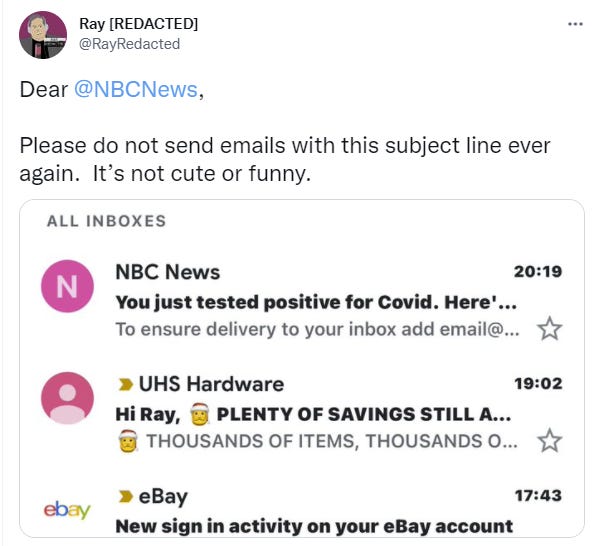
Also don’t respond to people’s taking positions you disagree with by attempting to shut down debate, which seems to have been our government’s reaction to proposals to reopen things before Very Serious People thought we were ready to do that.
Masks better than N95s are one of the best ways to get real protection and actually have a shot at avoiding Omicron. Alas, people often don’t let you use them, such as this account where someone who was immunocompromised wasn’t allowed to use one on a flight, and thinks that’s how they got Covid-19.
Helen Branswell’s ten lessons from the pandemic.
Current Paxlovid prescription requirements in New York. Seems like we’ve chosen to skip the impossible choice by simply not making deliberate decisions at all and seeing what happens. If our logistics are incompetent enough it might even work.
Thread calling for a return to normal.
Not Covid
More details on the history of attempts to stop at-home pregnancy tests.
I’m the most pro-development person you’ll find, but you know what I am confident without having to read the article definitely isn’t safe? This condo.

SMBC asks what counts as science. Or is it what counts as Science(tm)? That is the question, after all. I do think it’s true that (almost) every human who ever existed for long did at least some science, the same way they also all did math. I also think it’s true that most ‘looking at thing’ does not count as Doing Science To It, the same way that most practice is not deliberate practice and mostly doesn’t count, but that has nothing to do with following standard protocols.
A thread from Patrick McKenzie about an employee who quit, and some good related advice about one’s relationship to one’s job. Such epic fully avoidable failure. I’ve always been one to do what needs to be done when it needs to be done, but also true rest time must be scheduled regularly and guarded absolutely or it doesn’t exist.

I think the “symptoms are resolving” vs “no fever” confusion thing is most easily explained as, well, a result of the fact that DC runs on copy-editing far more than most people realize. You cannot imagine how intense senior civil servants can be while red-penning documents. I suspect the process is as follows:
1. The career staff generates a draft document for publication. In doing so, they sigh at how much the document will be changed before publication, and may even call it “feeding the grist mill” or something similar, where the expectation is that their work will be mangled
2. It is then circulated internal to the government for edits, both within the CDC and with other agencies
3. Someone whose objections would be really awkward to ignore wants to use their preferred term of “symptoms are resolving,” someone else wants to use “no fever”
4. At some point, a call is made by a random supervisory-level person to accept both edits and merge the terms together and accept the confusion, rather than waste time and political capital on overcoming the awkward phrasing
5. The costs of confusion on the public are at no point internalized but the people in the drafting process; indeed, any commentary on it is seen by the people insisting on the edits that the public cannot be trusted to make these calls.
I have no direct knowledge of this being true, to be clear; but have seen this sort of thing play out many times in DC in other contexts so am pattern-recognizing.
You simply CANNOT imagine how much more time the average government official spends on this stuff than object-level efforts. The FOIA’d emails where agency leaders (e.g., Fauci) are literally commenting word-by-word on drafts are the default, not the exception. (In fairness, these sorts of senior officials do genuinely catch wrong stuff that everyone else missed _often enough_ that it’s extremely hard to not do this; Dominic Cummings has a rant about how he ended up spending time on this as a spad that feels very relevant to DC as well)
A story of my recent visit to the doctor for non-Covid illness (Canada).
I phone them, tell them my symptoms, they schedule an appointment. I come in and am given the stock Covid checklist form which tells me that if I have any of the following symptoms I must LEAVE IMMEDIATELY and quarantine. I check the boxes indicating that I must LEAVE IMMEDIATELY, hand the form to the receptionist, and sit down in the waiting area. She takes the form, looks at it, and a while later the doctor comes to see me for a normal appointment.
Not only is all theatre, it only works because everyone knows it’s theatre. If anyone involved had taken the system seriously, I would not have gotten treatment.
Peterson’s “up yours” to Trudeau has a history. They kept promising freedoms only if you do this, and then this, and then this, and then this in Canada. And it never happened, no matter what they did. So by now any “reasonable” message from the government there doesn’t read like reasonable, but reads like fighting words.
“I was about to kick myself for not getting onto this method of analysis earlier, except that it’s not available anywhere else?”
The only reason I haven’t been tearing my hair out over the inadequacy of data collection for Covid, is that I’m already bald. If they were actively avoiding having good data on prevalence, I’m not sure what they’d do differently.
Are people following the various guidelines?
Re paxlovid and the unvaccinated:
Unvaccinated people are younger than vaccinated people on average, and probably more likely to have been previously infected. Seems natural that those traits should be anticorrelated with expecting that you’ll need paxlovid, so maybe that’s the explanation here?
There are a couple of critical questions re the German study that I haven’t been able to find answers to, even in translations of German sites:
1. Were people who hadn’t gotten a PCR test (what Croxford calls group 2) told that they had had covid *before or after* they were asked about symptoms? Because that completely changes the significance of those results. I would guess before, but it’s just a guess.
2. What were the rates of symptoms in group 3, people with no detectable history of covid? Because that’s what we need to compare to.
Could you reconsider signal-boosting the NHS app tweet, or confirm you think the poster is right? I have the impression it is highly misleading and maliciously quoted:
TL,DR: The app stores the venues you check-in into, which it is supposed to do. The NHS just says that in principle you could derive socio-economic information from those venues.
Longer: The statement (link below) says the app stores the *venues* people scanned into (voluntarily, via QR codes in real-world places) on the phone. They then say that these venues, in principle, could indicate a person’s racial or ethnic origin; political opinions; etc. This seems to be just a very precise, honest and accurate GDPR-y statement. I don’t see any indication for an update to include this function, nor any indication that the NHS would do this or use the data in any unnecessary ways.
I only checked the 2nd screenshot in the tweet, but with that being bullshit and FUD, I don’t trust the twitter user enough to bother with the rest.
https://www.gov.uk/government/publications/nhs-covid-19-app-privacy-information/nhs-covid-19-app-our-processing-of-special-categories-of-personal-data
Otherwise thank you again Zvi for your mostly excellent post, and for keeping up the good work for all of us!
Heads-up: UK unbiased numbers from ONS planned to be released tomorrow: https://www.ons.gov.uk/peoplepopulationandcommunity/healthandsocialcare/conditionsanddiseases/bulletins/coronaviruscovid19infectionsurveypilot/24december2021
Seconded on the NHS claim not seeming to hold up to a bit of digging. I’m plenty cynical enough to believe that this is something that could happen, I’m just not finding any evidence that it actually is. It’s possible that there’s context linking these together that would be more obvious to a UK resident, but from here in the US I’m not seeing it.
I’ve removed it given people are raising the concern, as it’s not load-bearing enough to justify the issue. My gut does say they are indeed planning something like this.
Thanks for writing these, Zvi! Your posts keep me well-informed of what happening as well as what is likely to happen in the future.
I have a couple of questions:
1. This is not the first time you’ve mentioned this, but you imply that an N95 is not sufficient to prevent risk of getting covid. Is this new because of omicron? What’s the data and reasoning behind this?
2. Relatedly, in a previous post, you write
“Note that this post mostly does not justify and explain its statements. I document my thinking, sources and analysis extensively elsewhere, little of this should be new.”
Where is the place to read about these? Also, I’d love to see how calibrated your predictions are — I know this can be gathered by going through all your previous posts but I figure you’ve actually been keeping track already.
1. No. An N95 is a big help, but it’s not immunity. The full filtering systems are, but they’re socially awkward.
2. I admit to not organizing the information in a good way, I simply haven’t had the time. If there’s a *particular* one you’re interested in I can try to answer.
I haven’t calculated calibration. I do know that at one point Rob Bensinger looked at my week-over-weeks and found them better than blind guessing, but whenever we calibrate it’s always a question of difficulty and baseline. I don’t think that “70% of your 70%s” is that informative…
Thanks for replying!
1. I see. If it’s not too much trouble, could you give a rough quantification on “big help”? Some statement like ‘X% chance that you’ll avoid covid as long you correctly wear an N95 whenever indoors for all of 2022’? With any necessary assumptions about behavior preferably specified.
2. First, I want to reiterate that I very much appreciate that you take any time to write anything at all, even if you think they could be better if you had spent more time on them.
I’m curious about your thought process and what data sources you looked at more so than any particular point, but how about
“21. You are probably going to get Omicron, if you haven’t had it already. The level of precaution necessary to change this assessment is very high, and you probably don’t want to pay that price.”
Re: calibration, couldn’t it also be useful for people to know how likely your confidence intervals are to be correct in addition to how difficult it is or how much better you do than a suitable baseline? For example, in a hypothetical scenario where one were to plan a vacation date based on your numbers.
1. I think your effective exposure while wearing a well-fit N95 can be thought of as being cut ~50% with wide error bars (you want the OTHER people wearing good N95s more than you want your own, and the effects multiply), but you can get that to 90%+ with the heavy-duty stuff.
2. (21) Is a synthesis thing, so the sources are flowing into the general model, which then flows into this. Which is based on expecting the exponential growth to only be stopped in January by infecting most people, and for people to be much more infectious than before while they have it. Model says that if you’re not locked down pretty hard during the peak (from now until at least March or so) you’re going to be exposed quite a lot. After that, you might get an easier ride, but we’re talking several months of the full thing at a minimum. Of course, if you value avoiding Covid more, maybe you do it anyway.
3. Calibration: I agree it would be useful, my point was that I think calibration isn’t that big a percentage of the things you’d want to know when judging someone’s prediction. It’s on my ‘what my assistant should do’ list but not that high up.
One big reason why N95 masks don’t prevent covid is because they don’t cover the eyes.
“The nasolacrimal duct serves as an anatomical bridge connecting ocular surface and respiratory tract, permitting the virus to get access to respiratory tissues from ocular surface by tears.”
[From “The paradoxical problem with COVID-19 ocular infection …”, Computational and Structural Biotechnology Journal, 2021#19, pages 1063-1071.]
Sensible comment from an Israeli: https://www.abc.net.au/news/2021-12-31/israel-orders-another-booster-to-fight-omicron/100730338
“There is no evidence that a fourth dose helps. And there is no evidence that it does not harm,” said Professor Ron Dagan, a paediatrician and infectious disease expert who is a member of the vaccine advisory panel and voted in favour of the recommendation.
“But you still have to make a decision.”
Yeah, that’s always a weird phrasing.
“There is no evidence that a fourth does doesn’t help. And there is no evidence that it does any harm.”
Thinking about vaccine passports:
– I think these will stay because COVID will become endemic and this opens up a market of life-long boosters. If not, set rules for the passport to expire after a arbitrary period vaguely based on the lowest estimates of how long immunity lasts (say 180 or 270 days), and this rule will justify itself. In time other vaccines already mandated for schoolchildren and/or whatever mundate purposes will be added onto the system to become a comprehensive health pass on the Chinese model, not to mention a social credit system once the surveillance infrastructure’s potential is fully exploited. This opens up a can of worms where missing a vaccination = underclass, and ideologues will abuse this to revoke the vaccine passports of their opponents (Trump was criticizing this when he saw Trumpist antivaxxers and said they “are playing into their game” – self-inflicted damage).
– If anywhere with a mandate/vaccine passport mandates booster shots and set a deadline for that, what about those who vaccinated late and aren’t eligible for boosters yet when the deadline comes? They will have to add a rule like Israel’s Green Pass that treats those who’re recently double-vaxxed as equal to those who’ve boosted until they are eligible for the boosters. Otherwise they’re treating those who’re willing to comply as those who aren’t, some of them will be insulted enough into not complying, and we’re looking at a burgeoning caste system.
– What about those who have vaccinated, but having their records screwed up by administrative errors? Those who received their 2nd shot late, or gave up after the first shot but later on changed their mind? How should they act? I don’t think they should cast their lots with those exiting the whole vaccine passport system.
– The longer the vaccine passport system stays without an apparent threat from the virus, the more enticing exitism becomes, because it is the quintessential dysfunctional institution that gets into the way of daily life.
I remember naively believing we would never need passports because we’d achieve herd immunity without the vaccine holdouts. Oh, those halcyon days of early 2021. So… I should probably know better than to be optimistic now, but I am actually optimistic that we’ll put vaccine passports behind us relatively quickly. For all the blunders, I do broadly believe the public health officials are acting in good faith, and that the measures taken are nominally intended to protect the health care system. When the health care system is objectively no longer under threat, I do not think we are going to maintain a passport system for long, just-for-fun.
Maybe I am not cynical enough, but my read here in Canada (where the passport system is quite entrenched) is that more than enough of us really want this behind us. We have cooperatively abided by this all in good faith, and we expect this to end once it’s objectively safe for this to end. If Omicron comes and goes without causing health care system demands to reach critical levels, as it appears it may, then I believe it signals the beginning of the end. If we can get through this, I think we will officially at the point where it is endemic and there are no longer enough immunologically naive members of society to threaten the health care system any longer. I would like to imagine our view on COVID vaccination/boosters/annual immunization will be similar to that of influenza going forward. Maybe with a bit sharper edge to the peer pressure to be immunized, but not a factor in whether or not you can go out for dinner.
I should maybe add a couple points of clarification, when I say I think “passports” will be behind us quickly, I mean for domestic non-essential activity, not international travel. I think proof of immunization for international travel could be with us for a long time to come. I also think mandates in certain workplaces will be with us for a long time to come. I do not think “papers please” will continue to be part of going to the pub indefinitely.
Speaking to the wisdom of the issue, it would Very Much be a matter of enlightened self-interest for public health officials to back right off NPIs ASAP once the threat to the health care system is objectively behind us. There could be a whole new pandemic in 18 months, and if we are going to get social buy-in for public health measures all over again for the next one, then public health officials need to demonstrate a record for fully backing off of those measures when it was safe to do so. CDC says it’s now safe for us to tell them to go eff themselves And we will.
I hope your view of medical policy-makers are correct, and I feel the leftover measures are relatively sensible from a vaxx-only view of prevention (you need to allow a way for those unable or unwilling to vaccinate to get in), but I’m not that naïve and my priors leans towards the more conspiratorial (“antivaxx”). I’ve stated clearly my belief in the endurance of vaccine passports in my first point, and there is strong incentives on the global level to apply centralizing digital technologies to administrative uses (look up “ID2020”). Vaccine passports are the perfect test case to digitally micromanage the population. It’s no coincidence that China’s social credit system and the FED’s proposal to liquidate the retail banking system coincide with the initial lockdowns. The best case scenario is the technology being a Damocles’ sword hanging over everyone and ready to be applied at the next crisis, and the worst case being 1984 and Brave New World combined.
(I don’t reject COVID vaccines as a concept)
I am vaxed and boosted and not immune. Our 4 year old got it and then it got the rest of the household. 2 boosted adults and a “fully-immunized” (2 shots) tween. Tween hit last after some effort to isolate her. But we all got it relatively quickly and it’s been nastier than anticipated for each of us, though no one had to seek care.
3 boosted adults, yet everybody got it after a 2-x vaxxed teen brought it in. They slept the fever off over night. Sadly, this was enough to get another vaxxed child and then the adults got it.
Nobody had anything exceeding unpleasant-cold-like symptoms (aged 40s and 70s).
In “Other news”, about the UK covid app:
1 — the link to the official announcement is broken, limiting my ability to verify this. I was able to follow through from the tweet follow-up link and see the source of the first one, but not the second.
2 — I don’t think the screenshots say what the guy screenshotting them thinks they say.
As far as I can tell, they’re warning you that data saying you went to “Menfriends sauna & adult shop” at 11pm on a Saturday might *indicate* something to anyone who has your device. Same deal with going to “St. Paul’s Anglican Worship Center” at 10am on a Sunday. Etc etc etc. If you write down where you’ve been, it could say a lot about you.
The second screenshot is saying that if you, say, have a severe phobia of vaccines leading to a rather difficult vaccination process (that’s me), that might be written down in your vaccine record. Which is possibly more info than needs to be there, but it seems fine overall. For the following items seperated by lines, please note the __lack__ of ‘X’s next to anything *other* than vaccination status.
The news of announcements of requirements of covid app things for rent, work etc seems scary if true, but again I do not think it’s true. The UK already does ‘right to work/right to rent’ checks where they ask for ID and immigration status etc, this just lets them do it remotely. Which enables remote work without face-to-face hiring etc. I also don’t think this is happening through the covid app?
tldr looks like government-overreach outrage bait.
Can you fact-check your own claims? I’m considering moving to the UK and I’m seeing if my issues will carry over here. I’m coming from a place where vaccine passports is still in the planning stage, and already massive economic failure has come beforehand because of this.
The app should be written to absolutely not leak the movement records outside the phone unless you explicitly authorize a certain portion of the record to be uploaded to the NHS database, and also allow an option of password protection against anyone grabbing your phone (tho not useful for stop and searches). Not likely when intelligence agencies are requesting backdoors all around.
If they plan to move ‘right to work/right to rent’ checks onto an app, just make it its own app and be open about it. No need to sneak anything other than your vaccination records into vaccine passport platform, unless they’re planning to transform it into social credits. And if those plans to exclude the unvaccinated from renting or even remote work are true (which make no public health sense), you’re looking at a shanty town & informal work/markets situation.
Has anyone seen anything more on a possible mouse source for the Omicron variant? Zvi linked to a tweet about it in a post a while back. This article seems interesting: https://www.sciencedirect.com/science/article/pii/S1673852721003738 The abstract concludes, “our results suggest that the progenitor of Omicron jumped from humans to mice, rapidly accumulated mutations conducive to infecting that host, then jumped back into humans, indicating an inter-species evolutionary trajectory for the Omicron outbreak.” Does anyone have a theory for how that could happen in nature, especially while also developing the ability to evade immunity in humans?
Reverse zoonosis is super common with influenza. It’s not a novel concept here.
Windows open in MN when outdoor temperature is 19 degrees Fahrenheit —> Indoor relative humidity goes nearly to zero as heating system is on full blast, and dry, cold air floods in. Result is damage to the lungs of all party-goers.
Some rather informative details from the UK’s Health Security Agency about ending isolation.
https://ukhsa.blog.gov.uk/2022/01/01/using-lateral-flow-tests-to-reduce-the-self-isolation-period/
Includes the estimate that 5% of people are contagious at 10 days, 16% at 7 days, but that it’s more like 5% of people at day 7 if they’ve had negative LFD tests on days 6 and 7.
Also explains the difference between UK and USA on when the clock starts ticking.
FYI, Rayaldee is calcifediol, which is a faster acting metabolite of the Vitamin D supplements you might normally buy at a store. Calcifediol is what worked in the Spanish trial in late 2020:
https://www.ncbi.nlm.nih.gov/labs/pmc/articles/PMC7456194/
Then they did a larger version with closer to 1,000 patients, where it also worked, I’m too lazy to dig up the link. Then people complained that the larger one was improperly randomized, then this seemed to get memory holed forever.
Lots of people have noticed that calcifediol seemed to work in the Spanish trial while vitamin D failed in other trials and wondered if maybe the standard vitamin D is not sufficiently fast acting to treat the disease if your levels are low at the onset of covid. Scott mentioned it in this post, but he just assumed the doctors running the trials knew better than he did which version to use:
https://astralcodexten.substack.com/p/covidvitamin-d-much-more-than-you
I don’t know any better than Scott or the doctors running the trials. But I’m just bringing this up because you’re cynically writing off Rayaldee as pharma rebranding a cheap product to profit from it. What’s going on here could be different than that.
That’s fair. It’s possible that as a treatment after getting your test it’s better.
And I’m very happy to let them money grab, system isn’t their fault.
Calcifediol may not be the most common form, but it’s easily available over the counter (in US) so I don’t think that counts as something exceptional about Rayaldee.
But agreed that that’s they’re just following their (dysfunctional) incentives here.
Could you link me to such a product? I’m having trouble finding such a supplement on sites like Amazon.
Fewer than I thought, actually, now that I dig a bit deeper! This is the only company I see on Amazon selling D as calcifediol is these folks, who have a couple of calcifediol products (mainly one by itself [linked] and one with zinc and C as well):
Sorry for the big commercial photo there — didn’t realize wordpress would expand amazon links like that. 🙄
The Israeli study finding that the booster is 90% additionally effective is incorrect, likely due to extracting the data just four days after the end of the study period. This produces a type of problem you’ve encountered in the past: in this case, it appears that participant deaths were only entered in the database after cause of death was determined; it further appears that there tended to be greater delay for this determination among the ‘boosted’ participants.
The annualized total mortality for boosted participants is an implausibly low 0.62% compared to 2.49% for non-boosted participants (U.S. annual mortality for the corresponding age range of this study is 3.10%). If the study were correct, it would make receiving a booster a ‘fountain of youth’.
Excluding the final 30 days of the study period appears to ameliorate this problem, but reduces the estimate of booster efficacy against covid-19 death to about 48% (still good, but far below 90% protection). However, there appear to be additional problems with the study.
I sent a query to the lead author (Ronen Arbel, Ph.D.) and received a reply that was still not consistent with the Figure 2 data. His explanation would account for the two periods I thought most implausible, but would invalidate the other seven periods (i.e., his response makes the problem worse).
Say that I am a doubly vaccinated female who recently found out that I was pregnant. Given that it is in my interest to protect the unborn baby, to what extent should I try to avoid getting infected with Omicron? Should I self-isolate and foreskae my work? Or is that too extreme?
I don’t want to be overly cautious but certainly I don’t wish to take unnecessary risks either. I find it hard to gauge how dangerous omicron is expected to be if you’re pregnant and doubly vaccinated, and could find no good data.
Not medical advice etc, but I don’t see why you should be worried about this once vaccinated. I would get boosted, of course, if you’re worried. But otherwise, I’d be worried about lack of access to care you need for the pregnancy in the near term (next 1-2 months) more than anything else.
No data is exactly the point. If this was a serious problem, the Very Serious People would be screaming about it to try and force vaccinations and precautions.